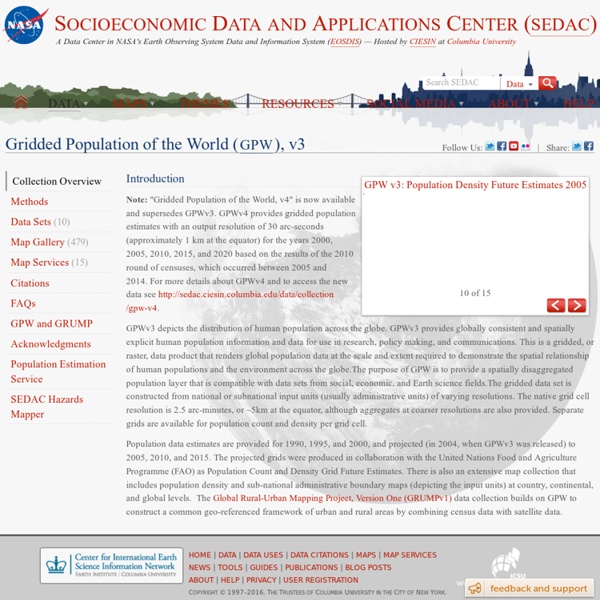



Map Collection Digital Maps The Harvard Map Collection is one of the oldest and largest collections of cartographic materials in the United States with over 500,000 items. Resources range from 16th century globes to modern maps and geographic information systems (GIS) layers. A selection of our materials has been digitally imaged and is offered both as true picture images and georeferenced copies. This Virtual Collection includes those maps and atlases that are available through the Harvard Image Delivery Service. Those maps that have been georeferenced are available through the Harvard Geospatial Library. Only a small portion of the Map Collection has been cataloged and included in the HOLLIS catalog and an even smaller selection are included in this virtual collection as digital images.
Flex Projector OnEarth, JPL WMS Server Mapping global urban and rural population distributions The previous chapter reviewed definitions of urban and rural areas, and analysed what statistical data are available and what georeferenced datasets could be used as potential inputs into models of population distribution. In this chapter, the two most widely known and used georeferenced global population distribution databases that have been developed based on these sources are reviewed and several recent efforts to model population distribution, taking urban and rural areas explicitly into account are described. The Gridded Population of the World (GPW), originally developed at the National Center for Geographic Information Analysis (NCGIA) and subsequently updated by the Center for International Earth Science Network (CIESIN) at Columbia University, attributes population to the lowest subnational administrative units for which population counts are available. The GPW project was the first major attempt to generate a consistent global georeferenced population dataset.
Global Population Density at a Glance (Infographic) Fathom Information Design/Promo image This population density map is making the rounds on the blogs today, to near-universal acclaim. And for good reason; it might be the most intuitive look at global pop. density ever cobbled together. The brainchild of Fathom Information Design, 'Dencity' uses small pixels to connote density, big ones to convey wide-open, unpopulated spaces. Fast Company explains why the design works: In the visual syntax of infographics and maps, bigger equals... well, bigger. Fathom Information Design/Promo image I don't really get what's so unorthodox about this; to me, it seems downright intuitive. China. Counterintuitive or not, it is indeed a brilliantly effective way to convey where population centers are grouped, and where there's still free range. Click here to view a larger image.
World Sunlight Map Watch the sun rise and set all over the world on this real-time, computer-generated illustration of the earth's patterns of sunlight and darkness. The clouds are updated daily with current weather satellite imagery. The Mercator projection used here is one way of looking at the spherical earth as a flat map. Used since the 16th century for navigation, straight lines on this map can be used accurately as compass bearings but the size and shape of continents are distorted. Compare this with Peters, Mollweide or equirectangular projection maps. Also available is a semi-realistic view of dawn and dusk from far above the Earth, a look at the moon, and information about how this works.
Alpage ALPAGE (diachronic analysis of the Paris urban area: a geomatic approach) is a research program coordinated by Hélène Noizet (LAMOP), which is supported by the ANR. Based on the association of 4 laboratories, and collaboration of many partners, it brings together some twenty researchers or academics in humanities, social sciences and communication studies. These historians, geomaticians and computer scientists are building a geographic information system (GIS) about the pre-industrial Parisian area. The concluding symposium, held on 7 and 8 june 2010, ended the first phase of this program (scheduled for release in January 2013). Beyond 2011, the work is going on thanks to masters degree students and to the support of CNRS, with the TGE ADONIS. Production work data, which benefited until June 2011 supported by the CNRS, continues through individual research specific to individual researchers or students, allowing regular updating of the mapping platform.
Technical Information About the National Atlas Web Map Service As an example, the following map request will generate the map in Figure 1. Note that the resulting map displays the Seismic Hazard layer ("seihaz") and the States layer ("states"). Figure 1: Example map image All layers in the National Atlas WMS have unique names. seihazGeology - Seismic Hazard xlink:href=" Figure 2: A portion of the Geology GetCapabilities file describing the Seismic Hazard layer. When GetMap parameter values are invalid, an error message will indicate which parameter/value pair is invalid according to the format of the Exceptions type. Getting the Legend Graphic The URL for the legend graphic is available in the GetCapabilities file between the OnlineResource tag, which is within the LegendURL tag (Figure 2). Table 4: GetLegendGraphic Request Parameters
List of countries by population growth rate The population growth rate estimates (by United Nations) for the period 2005–2010 using the medium variant. This article includes three lists of countries and self-governing dependent territories by population growth rate. Methodology[edit] The first list is based on the estimates taken from the 2006 edition of the United Nations World Population Prospects report.[1] Figures are population growth rate estimates for the period 2005–2010 using the medium variant. The second list is based on CIA World Factbook estimates for year 2011.[2] Dependent territories and not fully recognized states are not ranked. The third list is based on World Bank estimates for year 2009.[3] Population is based on the de facto definition of population, which counts all residents regardless of legal status or citizenship—except for refugees not permanently settled in the country of asylum, who are generally considered part of the population of the country of origin. Countries[edit] See also[edit] World population